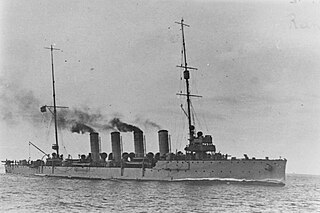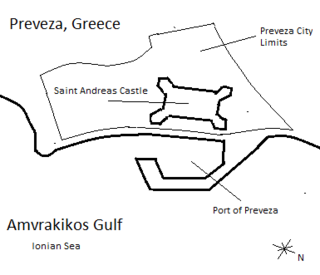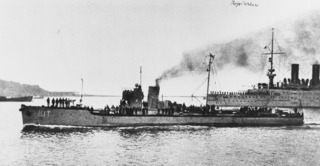
The Regia Marina or Royal Italian Navy was the navy of the Kingdom of Italy from 1861 to 1946. In 1946, with the birth of the Italian Republic, the Regia Marina changed its name to Marina Militare.

SMS Novara was a Novara-class scout cruiser of the Austro-Hungarian Navy which served during World War I. Built by the Danubius shipyard between December 1912 and January 1915, Novara was the third and final member of her class to enter service, some six months after the start of the war. She was armed with a battery of nine 10-centimeter (3.9 in) guns and had a top speed of 27 knots.

T3 was a sea-going torpedo boat that was operated by the Royal Yugoslav Navy between 1921 and 1941. Originally 78 T, a 250t-class torpedo boat of the Austro-Hungarian Navy built in 1914, she was armed with two 66 mm (2.6 in) guns, four 450 mm (17.7 in) torpedo tubes, and could carry 10–12 naval mines. She saw active service during World War I, performing convoy, escort and minesweeping tasks, anti-submarine operations and shore bombardment missions. In 1917 the suffixes of all Austro-Hungarian torpedo boats were removed, and thereafter she was referred to as 78. She was part of the escort force for the Austro-Hungarian dreadnought Szent István during the action that resulted in the sinking of that ship by Italian torpedo boats in June 1918.

The Bombardment of Ancona was a naval engagement of the Adriatic Campaign of World War I between the navies of Italy and Austria-Hungary. Forces of the Imperial and Royal Navy attacked and bombarded military and civilian targets all across Ancona in central Italy and several other nearby islands and communities in response to Italy's declaration of war on Austria-Hungary.

The Battle of Preveza was the first naval engagement fought during the Italo-Turkish War, which took place in the Ionian Sea on 29–30 September 1911. The action took part in two separate engagements, the first off Preveza, and the second at Gomenítza the following day. Five Italian destroyers encountered a pair of Ottoman torpedo boats off the port of Preveza on 29 September and forced one aground; the second fled into the safety of Preveza. The next day, the Italian destroyers raided Gomenítza, where another two torpedo boats and an armed yacht were at anchor. The Italians sank both torpedo boats and seized the yacht as a prize.

T1 was a seagoing torpedo boat that was operated by the Royal Yugoslav Navy between 1921 and 1941. Originally 76 T, a 250t-class torpedo boat of the Austro-Hungarian Navy built in 1914, she was armed with two 66 mm (2.6 in) guns and four 450 mm (17.7 in) torpedo tubes, and could carry 10–12 naval mines. She saw active service during World War I, performing convoy, escort and minesweeping tasks, anti-submarine operations and shore bombardment missions. In 1917 the suffixes of all Austro-Hungarian torpedo boats were removed, and thereafter she was referred to as 76. She was part of the escort force for the Austro-Hungarian dreadnought Szent István during the action that resulted in the sinking of that ship by Italian torpedo boats in June 1918. Following Austria-Hungary's defeat later that year, she was allocated to the Navy of the Kingdom of Serbs, Croats and Slovenes, which became the Royal Yugoslav Navy, and was renamed T1. At the time, she and seven other 250t-class boats were the only modern sea-going vessels of the fledgling maritime force.

The Soldato class was a class of destroyers of the Italian Regia Marina built by Ansaldo of Genoa prior to the First World War. Ten were built for the Regia Marina between 1905 and 1910, while an eleventh ship was built for China but purchased by Italy before completion. They served during the First World War, where one was lost, with the remaining ships sold for scrap in the 1920s and early 1930s.

Quarto was a unique protected cruiser built by the Italian Regia Marina in the 1910s. Her keel was laid in November 1909, she was launched in August 1911, and was completed in March 1913. She was the first Italian cruiser to be equipped with steam turbines, which gave her a top speed of 28 knots. Her high speed was a requirement for the role in which she was designed to serve: a scout for the main Italian fleet.

Marano Lagoon is a huge lagoon in northeastern Italy. It has a surface area of around 160 square kilometres.

The 250t class were high-seas torpedo boats built for the Austro-Hungarian Navy between 1913 and 1916. A total of 27 boats were built by three shipbuilding companies, with the letter after the boat number indicating the manufacturer. There were small variations between manufacturers, mainly in the steam turbines used, and whether they had one or two funnels. The eight boats of the T-group, designated 74 T – 81 T, were built by Stabilimento Tecnico Triestino, located at Trieste. The sixteen boats of the F-group, 82 F – 97 F, were built by Ganz-Danubius at their shipyards at Fiume and Porto Re. The three M-group boats, 98 M – 100 M, were manufactured by Cantiere Navale Triestino at Monfalcone.

Casque was one of a dozen Bouclier-class destroyers built for the French Navy in the first decade of the 20th century. She was sold for scrap in 1927.

The Yugoslav torpedo boat T5 was a sea-going torpedo boat operated by the Royal Yugoslav Navy between 1921 and 1941. Originally 87 F, a 250t-class torpedo boat of the Austro-Hungarian Navy built in 1914–1915, she was armed with two 66 mm (2.6 in) guns and four 450 mm (17.7 in) torpedo tubes, and could carry 10–12 naval mines. She saw active service during World War I, performing convoy, patrol, escort and minesweeping tasks, anti-submarine operations and shore bombardment missions. Following Austria-Hungary's defeat in 1918, 87 F was allocated to the Navy of the Kingdom of Serbs, Croats and Slovenes, which became the Royal Yugoslav Navy, and was renamed T5. At the time, she and the seven other 250t-class boats were the only modern sea-going vessels of the fledgling maritime force.

T2 was a seagoing torpedo boat operated by the Royal Yugoslav Navy between 1923 and 1939. Originally 77 T, a 250t-class torpedo boat of the Austro-Hungarian Navy built in 1914, she was armed with two 66 mm (2.6 in) guns, four 450 mm (17.7 in) torpedo tubes, and could carry 10–12 naval mines. She saw active service during World War I, performing convoy, patrol, escort, minesweeping and minelaying tasks, anti-submarine operations, and shore bombardment missions. In 1917, the suffixes of all Austro-Hungarian torpedo boats were removed, and thereafter she was referred to as 77. Present in the Bocche di Cattaro during the short-lived mutiny by Austro-Hungarian sailors in early February 1918, her crew remained loyal. 77 was part of the escort force for the Austro-Hungarian dreadnought Szent István during the action that resulted in the sinking of that ship by Italian torpedo boats in June 1918.

The Novara class was a class of three scout cruisers built for the Austro-Hungarian Navy. Named for the Battle of Novara, the class comprised SMS Saida, SMS Helgoland, and SMS Novara. Construction started on the ships shortly before World War I; Saida and Helgoland were both laid down in 1911, Novara followed in 1912. Two of the three warships were built in the Ganz-Danubius shipyard in Fiume; Saida was built in the Cantiere Navale Triestino shipyard in Monfalcone. The Novara-class ships hold the distinction for being the last cruisers constructed by the Austro-Hungarian Navy.

SMS Lika was one of six Tátra-class destroyers built for the kaiserliche und königliche Kriegsmarine shortly before the First World War. Completed in August 1914, she helped to sink an Italian destroyer during the action off Vieste in May 1915 after Italy declared war on Austria-Hungary. Two months later the ship participated in an unsuccessful attempt to recapture a small island in the Central Adriatic Sea from the Italians. In November and early December Lika was one of the ships conducting raids off the Albanian coast to interdict the supply lines between Italy and Albania. The ship was sunk in Durazzo harbor during the early stages of the 1st Battle of Durazzo in late December after striking several mines.

SMS Triglav was one of six Tátra-class destroyers built for the kaiserliche und königliche Kriegsmarine shortly before the First World War. Completed in August 1914, the ship participated in an unsuccessful attempt to recapture a small island in the Central Adriatic Sea from the Italians in July 1915. In November and early December Triglav was one of the ships conducting raids off the Albanian coast to interdict the supply lines between Italy and Albania. She was crippled by a mine during the 1st Battle of Durazzo in late December, but was taken in tow. The ship had to be abandoned when the Austro-Hungarian ships were spotted on the return voyage and she was sunk by French destroyers.

SMS Orjen was one of six Tátra-class destroyers built for the kaiserliche und königliche Kriegsmarine shortly before the First World War. Completed in 1914, she helped to sink an Italian destroyer during the action off Vieste in May 1915 after Italy declared war on Austria-Hungary. Two months later the ship participated in an unsuccessful attempt to recapture a small island in the central Adriatic Sea from the Italians. In November and early December Orjen was one of the ships conducting raids off the Albanian coast to interdict the supply lines between Italy and Albania, although she did not participate in the First Battle of Durazzo in late December. Orjen participated in several raids on the Otranto Barrage in 1916–1917 with limited success. She was transferred to Italy in 1920 in accordance with the peace treaties ending the war and renamed Pola. She mostly served as a training ship or in Italian North Africa when she was not in reserve from 1924 to 1928. Renamed Zenson in 1931, the ship was scrapped in 1937.
SMS Triglav was one of four Ersatz Triglav-class destroyers built for the kaiserliche und königliche Kriegsmarine during the First World War. Completed in 1917, she participated in several unsuccessful raids on the Otranto Barrage later that year. She was transferred to Italy in 1920 in accordance with the peace treaties ending the war and renamed Grado. The Regia Marina kept her in service until 1937 and the ship was subsequently scrapped.













